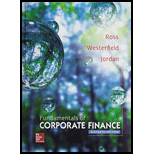
You deposited $2,000 in a bank account that pays 5 percent simple interest. How much will you have in this account after three years?
To calculate: The future value of $2,000 after 3 years at a simple interest rate of 5 percent
Introduction:
The future value of money refers to the amount of dollars that an investment grows over a definite period at a particular rate of interest rate. In other words, it refers to the future value of present cash investments. Simple interest refers to the interest earned on the initial principal every year.
Answer to Problem 5.1CTF
The future value of $2,000 at a simple interest rate of 5 percent after three years is $2,300.
Explanation of Solution
Given information:
Person X deposits $2,000 in his bank account. The simple interest received on the account is 5 percent.
The formula to calculate the future value when the bank provides simple interest:
Where,
“FV” refers to the future value
“P” refers to the principal amount invested
“r” refers to the simple rate of interest
“t” refers to the number of years or periods of investment
Compute the future value:
Hence, the future value is $2,300.
Want to see more full solutions like this?
Chapter 5 Solutions
Fundamentals of Corporate Finance with Connect Access Card
- You invest 60% of your money in Asset A (expected return = 8%, standard deviation = 12%) and 40% in Asset B (expected return = 5%, standard deviation = 8%). The correlation coefficient between the two assets is 0.3. What is the expected return and standard deviation of the portfolio? helparrow_forwardImporters and exporters are key players in the foreign exchange market. Question 10 options: True Falsearrow_forwardTriangle arbitrage helps keep the currency market in equilibrium. Question 9 options: True Falsearrow_forward
- The use of dividends is a method by which a foreign subsidiary can remit cash to its parent company. Question 8 options: True False\arrow_forwardThe notion that exchange rates adjust to keep the purchasing power of a currency constant across countries is called: Question 7 options: Interest rate parity. The unbiased forward rates condition. Uncovered interest rate parity. Purchasing power parity. The international Fisher effect.arrow_forwardThe notion that exchange rates adjust to keep the purchasing power of a currency constant across countries is called: Question 7 options: Interest rate parity. The unbiased forward rates condition. Uncovered interest rate parity. Purchasing power parity. The international Fisher effect.arrow_forward
- Suppose the direct exchange rate for the Canadian dollar and U.S. dollar is 1.11, this means that you can buy $1 U.S. for $1.11 Canadian. Question 5 options: True Falsearrow_forwardThe 60-day forward rate for Japanese Yen is x108.02 per $1. The spot rate is x103.09 per $1. In 60 days you expect to receive x1,500,000. If you agree to a forward contract, how many dollars will you receive in 60 days? Question 4 options: $154.635 million $15,312 million $13,886 million $14,550 millionarrow_forwardPlease provide correct solution with financial accounting questionarrow_forward
- Principles of Accounting Volume 2AccountingISBN:9781947172609Author:OpenStaxPublisher:OpenStax College
 Intermediate Accounting: Reporting And AnalysisAccountingISBN:9781337788281Author:James M. Wahlen, Jefferson P. Jones, Donald PagachPublisher:Cengage Learning
Intermediate Accounting: Reporting And AnalysisAccountingISBN:9781337788281Author:James M. Wahlen, Jefferson P. Jones, Donald PagachPublisher:Cengage Learning EBK CONTEMPORARY FINANCIAL MANAGEMENTFinanceISBN:9781337514835Author:MOYERPublisher:CENGAGE LEARNING - CONSIGNMENT
EBK CONTEMPORARY FINANCIAL MANAGEMENTFinanceISBN:9781337514835Author:MOYERPublisher:CENGAGE LEARNING - CONSIGNMENT



